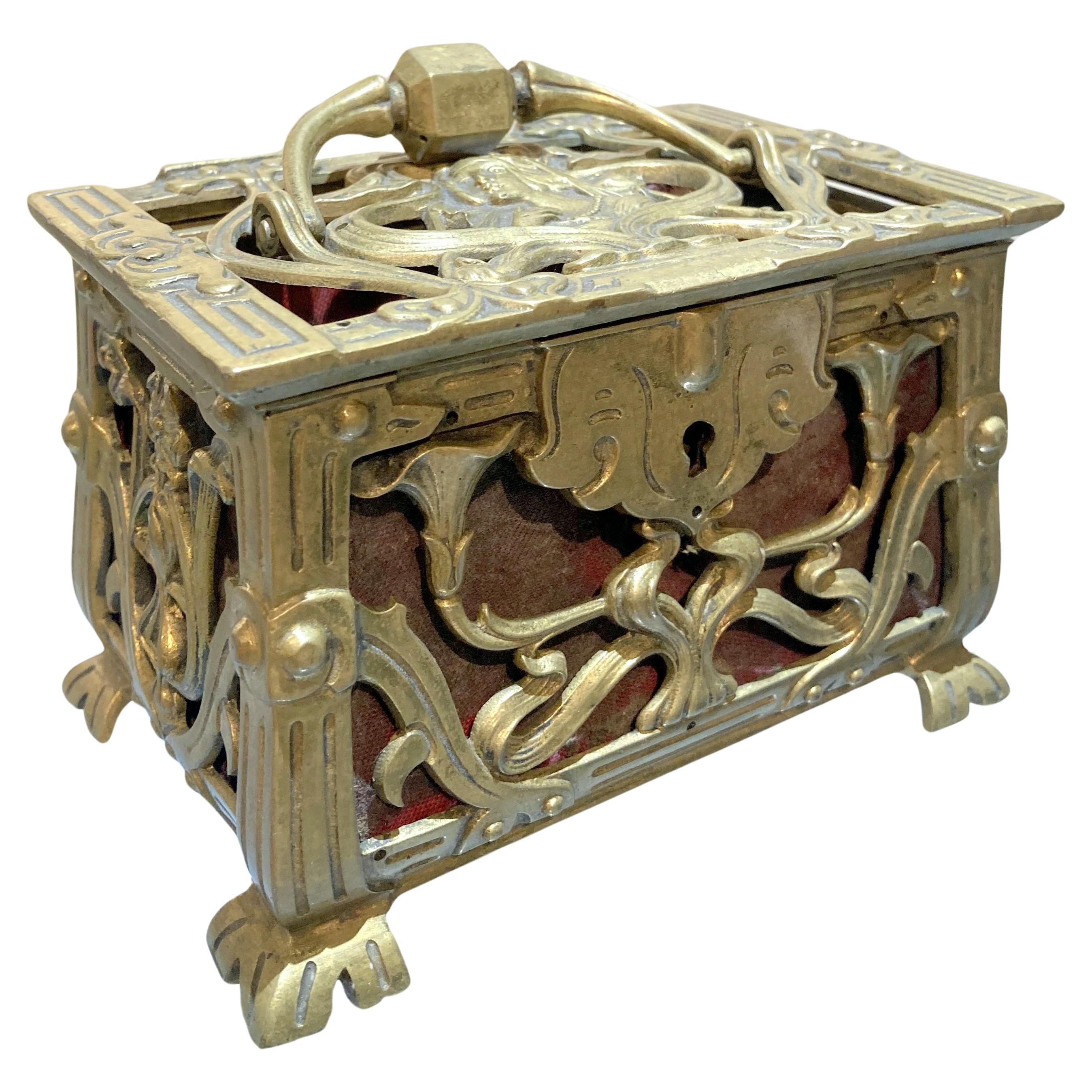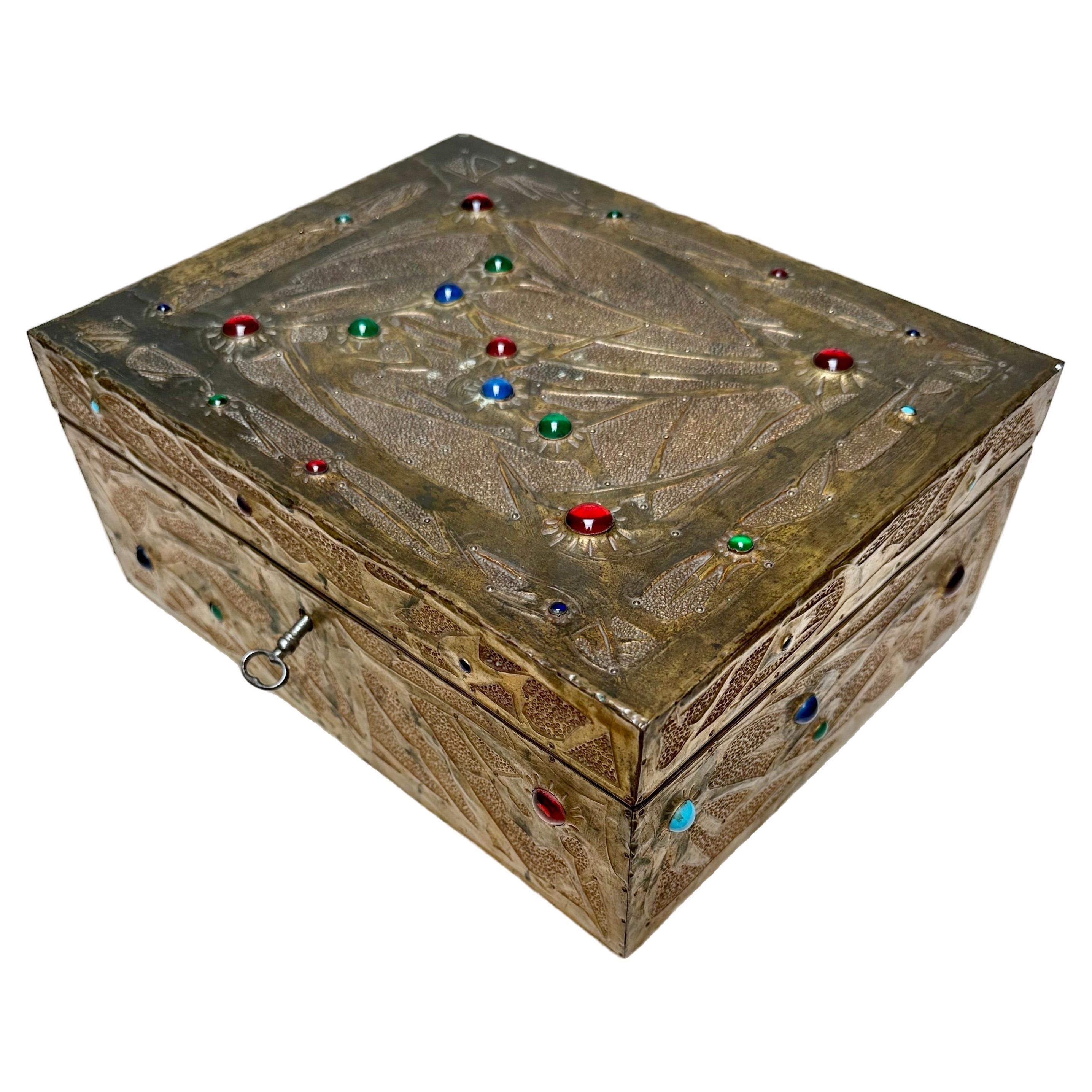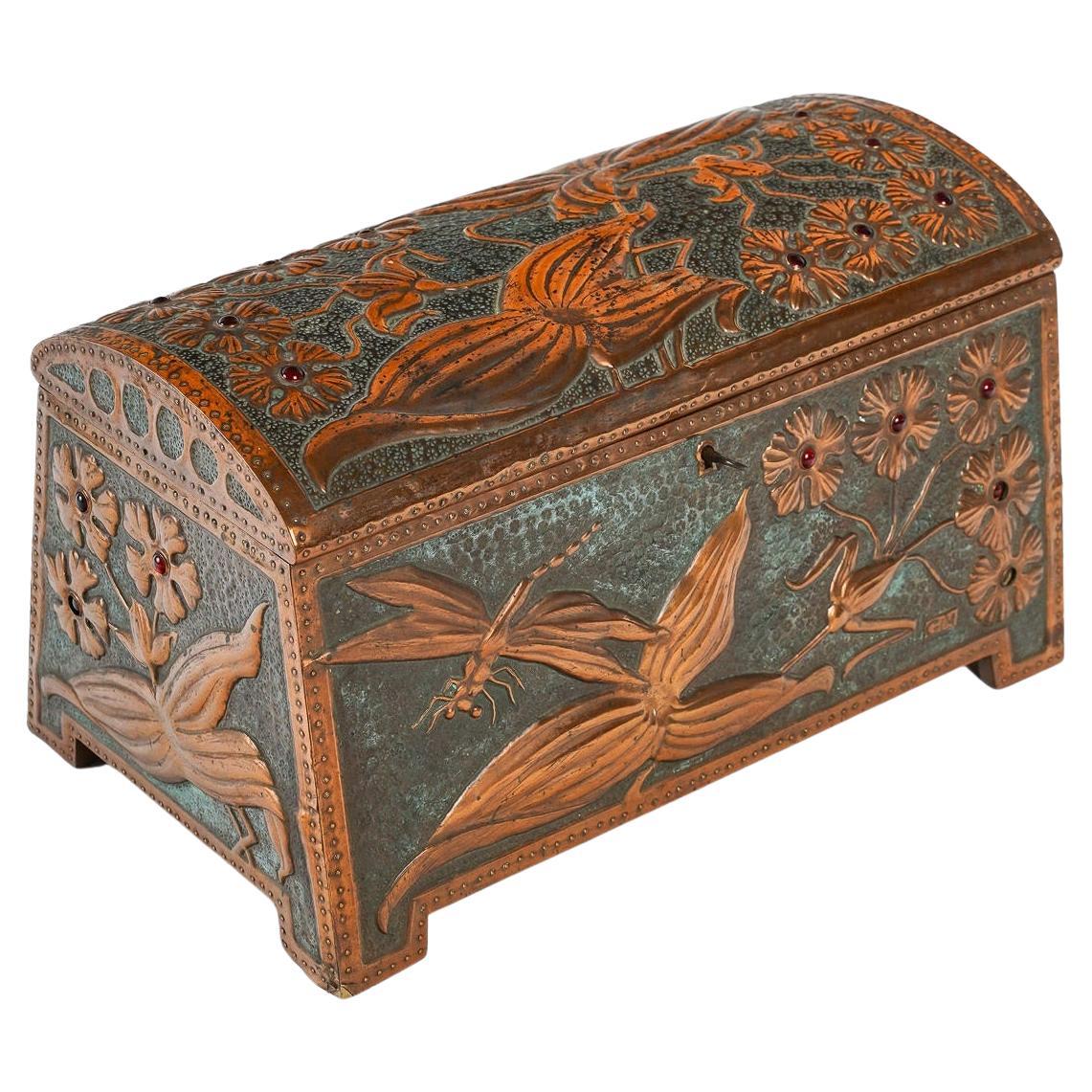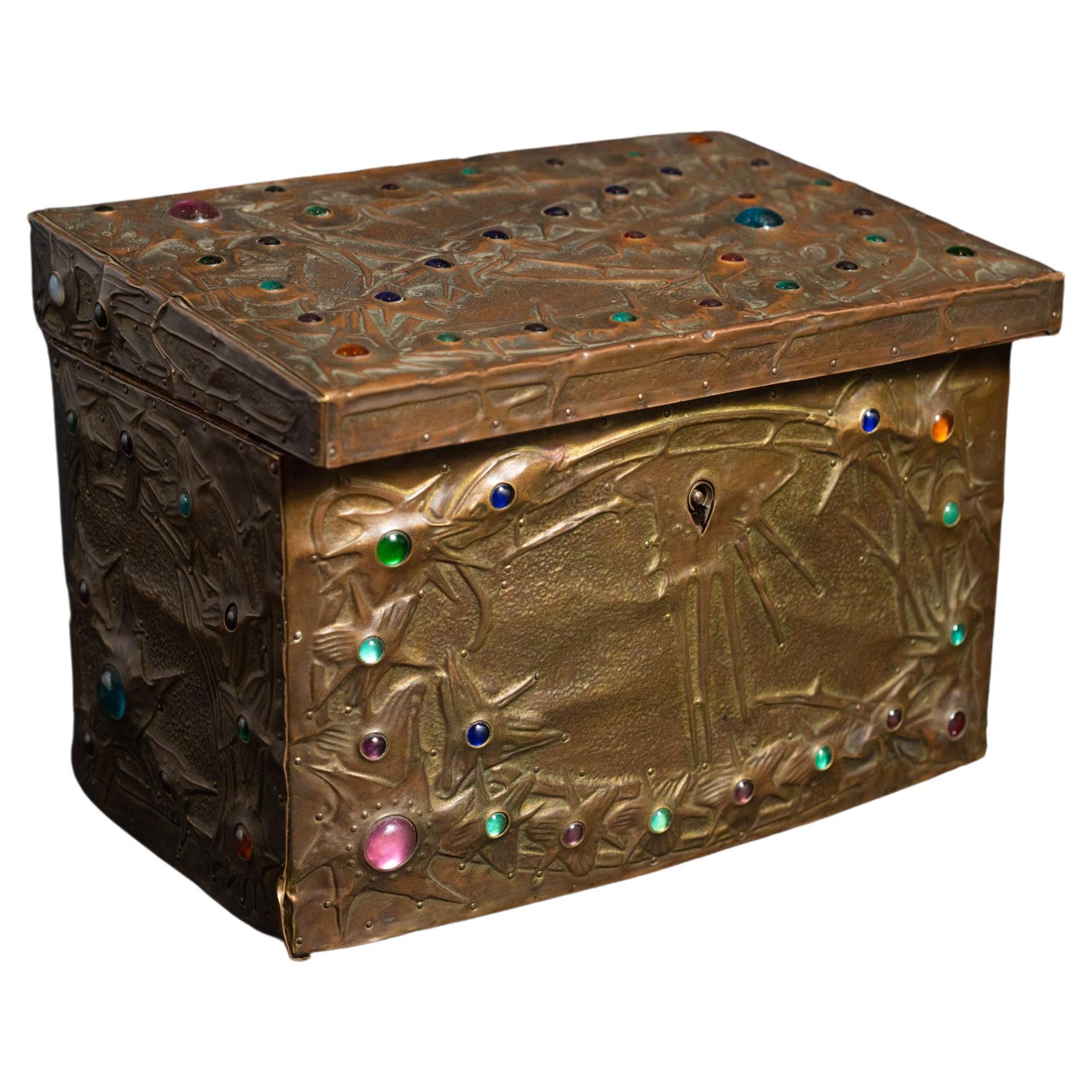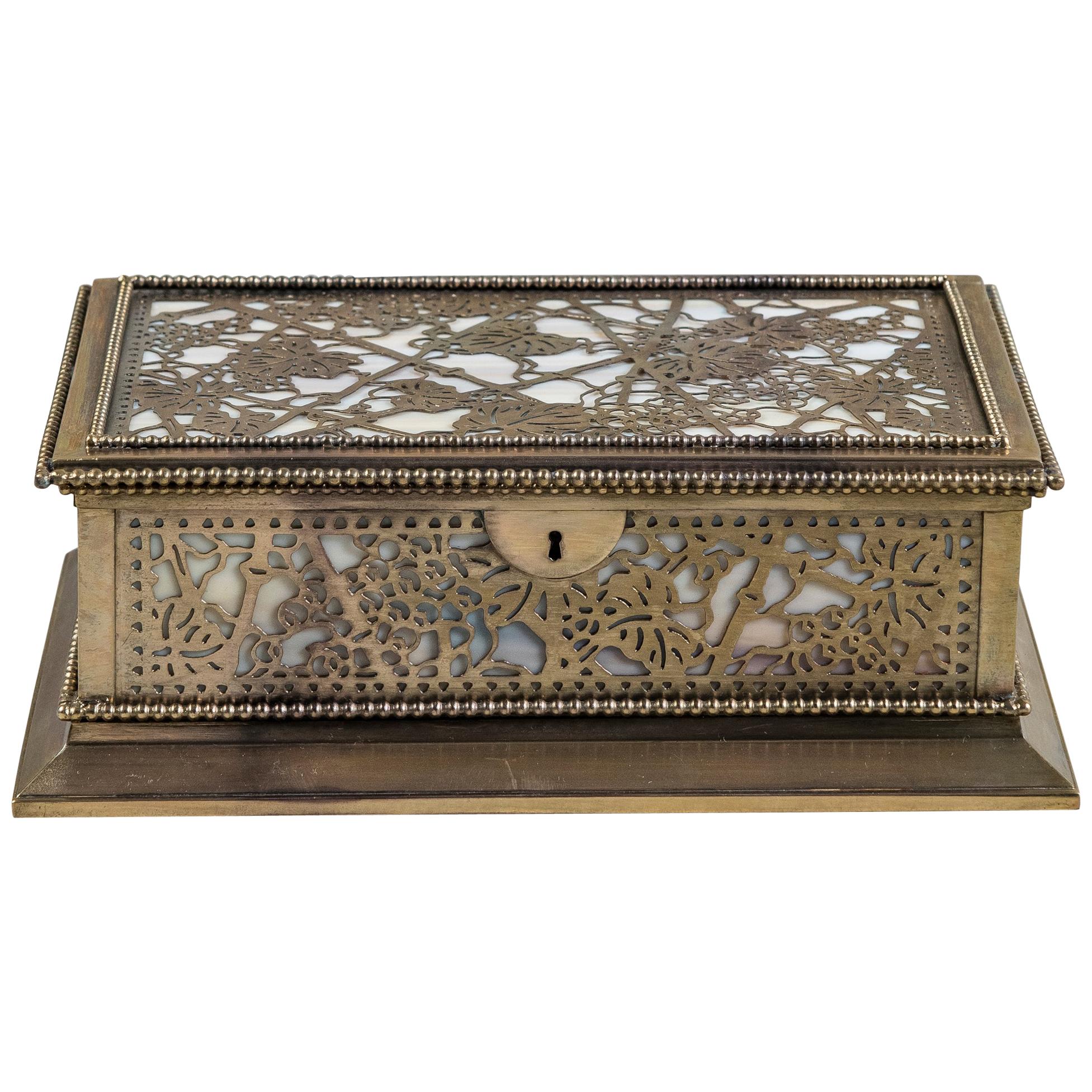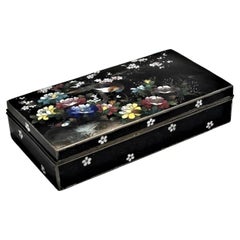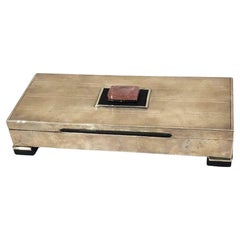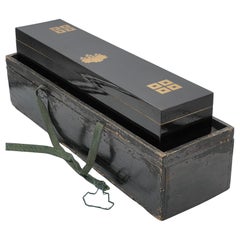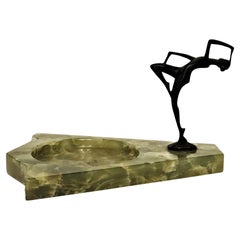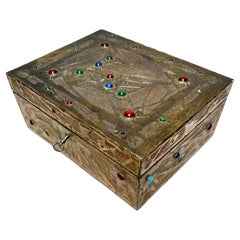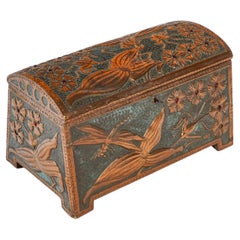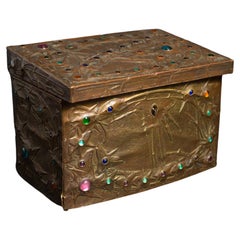Items Similar to Continental Art Nouveau Copper, Glass & Wood Jewelry Box, Ca. 1900
Want more images or videos?
Request additional images or videos from the seller
1 of 14
Continental Art Nouveau Copper, Glass & Wood Jewelry Box, Ca. 1900
$2,400
£1,821.06
€2,082.22
CA$3,352.15
A$3,727.13
CHF 1,946.10
MX$45,368.29
NOK 24,831.43
SEK 23,265.87
DKK 15,540.03
Shipping
Retrieving quote...The 1stDibs Promise:
Authenticity Guarantee,
Money-Back Guarantee,
24-Hour Cancellation
About the Item
Continental
Art Nouveau
Jewelry Box
Bronzed Copper, Wood, Glass
Ca. 1900
DIMENSIONS
Height: 4.-3/4 inches Width: 14-1/4 inches Depth: 3-7/8 inches
ABOUT
This exquisite jewelry box, likely of French or Austrian origin, boasts an extraordinary design that combines elegance, beauty, and originality, dating from around 1900. At first glance, it evokes the image of a natural gold nugget adorned with sparkling gemstones. However, upon closer inspection, it reveals its true craftsmanship: a wooden frame encased in delicate copper plates, each embossed with asymmetrical organic patterns and set with multicolored glass cabochons. The interior is lined with French silk featuring a charming floral print, adding an extra touch of refinement to this one-of-a-kind piece.
- Dimensions:Height: 4.75 in (12.07 cm)Width: 14.25 in (36.2 cm)Depth: 3.88 in (9.86 cm)
- Style:Art Nouveau (Of the Period)
- Materials and Techniques:Copper,Bronzed
- Place of Origin:
- Period:1900-1909
- Date of Manufacture:ca. 1900s
- Condition:Wear consistent with age and use. We make our best effort to provide a fair and descriptive condition report. Please examine photos attentively for they are an important part of the description. Send us a message to request more details or discuss price.
- Seller Location:New York, NY
- Reference Number:1stDibs: LU2819342434872
About the Seller
5.0
Vetted Professional Seller
Every seller passes strict standards for authenticity and reliability
Established in 1993
1stDibs seller since 2017
83 sales on 1stDibs
Typical response time: 11 hours
- ShippingRetrieving quote...Shipping from: New York, NY
- Return Policy
Authenticity Guarantee
In the unlikely event there’s an issue with an item’s authenticity, contact us within 1 year for a full refund. DetailsMoney-Back Guarantee
If your item is not as described, is damaged in transit, or does not arrive, contact us within 7 days for a full refund. Details24-Hour Cancellation
You have a 24-hour grace period in which to reconsider your purchase, with no questions asked.Vetted Professional Sellers
Our world-class sellers must adhere to strict standards for service and quality, maintaining the integrity of our listings.Price-Match Guarantee
If you find that a seller listed the same item for a lower price elsewhere, we’ll match it.Trusted Global Delivery
Our best-in-class carrier network provides specialized shipping options worldwide, including custom delivery.More From This Seller
View AllChinese Art Deco, Bird & Flower Motif Cloisonné Enamel Trinket Box, Ca. 1920
Located in New York, NY
Chinese Art Deco
Bird & Flower Motif
Cloisonné enamel trinket box
ca. 1920
DIMENSIONS:
Height: 1.75 inches
Width: 6.75inches
Depth: 3.75...
Category
Vintage 1920s Chinese Art Deco Jewelry Boxes
Materials
Metal
English Art Deco Silver, Quartz, Onyx & Wood Table Cigarette Box, Ca. 1930s
Located in New York, NY
English Art Deco
Table Cigarette Box
Sterling Silver 925°
Pink Quartz, Black Onyx, Natural & Ebonized Wood
Circa 1930s
DIMENSIONS
Height: 3.25...
Category
Vintage 1930s British Art Deco Sterling Silver
Materials
Silver
Japanese Meiji Period Lacquered Wooden Box w/ Original Outer Case, Ca. 1880
Located in New York, NY
Japanese Meiji Period Lacquered Wooden Box w/ Original Outer Case, Ca. 1880
Meiji Period: 1868-1912
DIMENSIONS
Length: 16.5 inches
Width: 3.5 inches
Height: 2.5 inches
Category
Antique 1880s Japanese Japonisme Jewelry Boxes
Materials
Wood
Austrian Art Deco Bronze and Green Agate Vide-Poche, ca. 1920s
Located in New York, NY
Austrian Art Deco
Vide-Poche
Bronze and Green Agate
ca. 1920s
ABOUT
Vide Poche (meaning 'empty pocket' in French) is intended to be a trinket tray used for holding the contents of ...
Category
Vintage 1920s Austrian Art Deco Decorative Dishes and Vide-Poche
Materials
Agate, Bronze
Chinese Art Deco Enameled Bronze Inkwell w/ Bird and Flower Motif, ca. 1920
Located in New York, NY
Chinese Art Deco
Enameled Bronze Inkwell
w/ Bird and Flower Motif
ca. 1920
Dimensions:
Height: 2.5 inches.
Width: 6.75 inches.
Depth: 3.5 inches.
Category
Vintage 1920s Chinese Art Deco Inkwells
Materials
Brass
Art Nouveau Sculptural Gilded Vienna Bronze Candy Bowl, ca. 1900
Located in New York, NY
Probably, Austrian, this very original Art Nouveau orientalist sculptural candy bowl made of gilded Viennese bronze, depicts a young street vendor in bloomers and a fez, holding a hu...
Category
Antique Early 1900s Austrian Art Nouveau Decorative Bowls
Materials
Bronze
You May Also Like
Antique 19th Century French Art Nouveau Pierced Gilt Bronze Jewelry Box
Located in Firenze, IT
This lavish French Art Nouveau period (1880-1910) jewelry box is entirely chiseled, hammered and pierced with flowers and leaf patterns. This late 19th – early 20th century rectangul...
Category
Antique Late 19th Century French Art Nouveau Jewelry Boxes
Materials
Bronze
Alfred Daguet, Paris, Art Nouveau Embossed Brass & Inlaid Glass Cabochons Box
By Alfred Daguet
Located in Lisse, NL
One of a kind and all hand-crafted, good size antique box by Alfred Daguet (1875-1942).
Alfred Daguet was a French craftsman/metalsmith, active around the early 1900s and who specia...
Category
Early 20th Century French Arts and Crafts Jewelry Boxes
Materials
Brass, Copper
Art Nouveau Repoussé Copper Box, circa 1900.
Located in Saint-Ouen, FR
Art Nouveau repoussé copper box, circa 1900.
Art Nouveau style box, 1900, embossed copper on a wooden interior, red glass cabochons, with key.
D...
Category
20th Century French Art Nouveau Decorative Boxes
Materials
Copper
Art Nouveau Cosmic Repoussé Box by Alfred Daguet
By Alfred Daguet
Located in Chicago, US
Alfred Louis Achille DAGUET (1875 - 1942) was a metalsmith active in Paris during the first part of the 20th century. His metalwork created prior to the outbreak of World War I, note...
Category
Antique Early 1900s French Art Nouveau Decorative Boxes
Materials
Copper
Vintage Regency Tiffany Studios Bronze Box
Located in West Palm Beach, FL
Step into timeless sophistication with this extraordinary vintage Tiffany Studios bronze box, richly adorned in intricate relief work and crowned with iridescent cabochon accents. Th...
Category
Early 20th Century American Hollywood Regency Decorative Boxes
Materials
Bronze
Bronze and Slag Glass Tiffany Jewelry Box, Art Deco Period, United States
By Tiffany Studios
Located in Buenos Aires, Buenos Aires
Bronze and slag glass Tiffany jewelry box. Art Deco period. United States, circa 1900. Signed at the back "Tiffany Studios 823".
Category
Early 20th Century American Art Deco Jewelry Boxes
Materials
Bronze
More Ways To Browse
Gemstone Jewellery Box
Gold Glass Jewelry
Art Nouveau Wood Furniture
Antique Art Nouveau Jewelry
Antique French Silk
Floral Jewelry Box
Antique Copper Glass
Gold And Wood Jewellery
Encased Jewelry
Glass Cabochon Jewelry
Antique Bedroom Sets 1900
Copper Art Jewelry
Antique Gold Plated Jewellery
Antique Jewelry Print
Continental Jewelry
Wood Box 1900s
Natural Gold Nugget
Antique 3 Piece Bedroom Set
